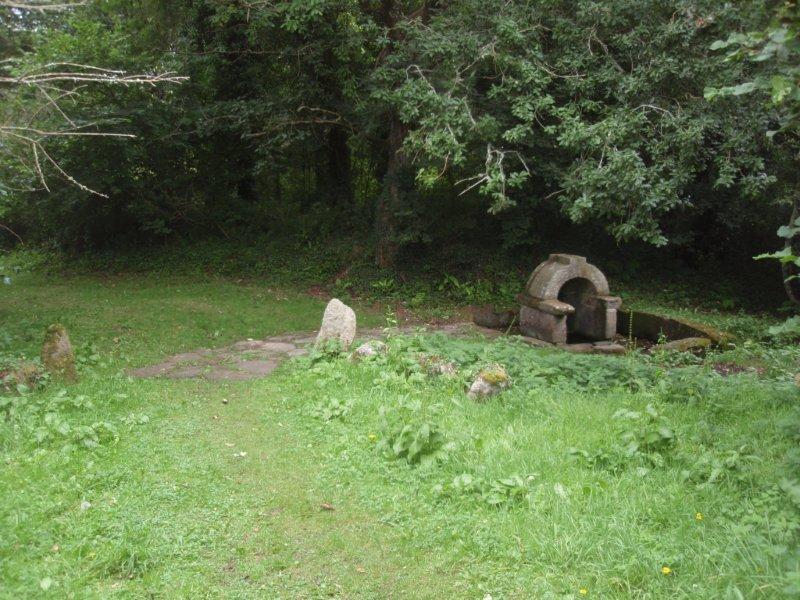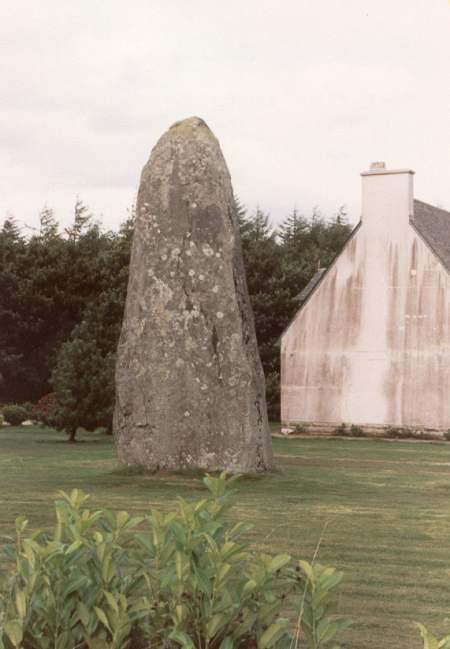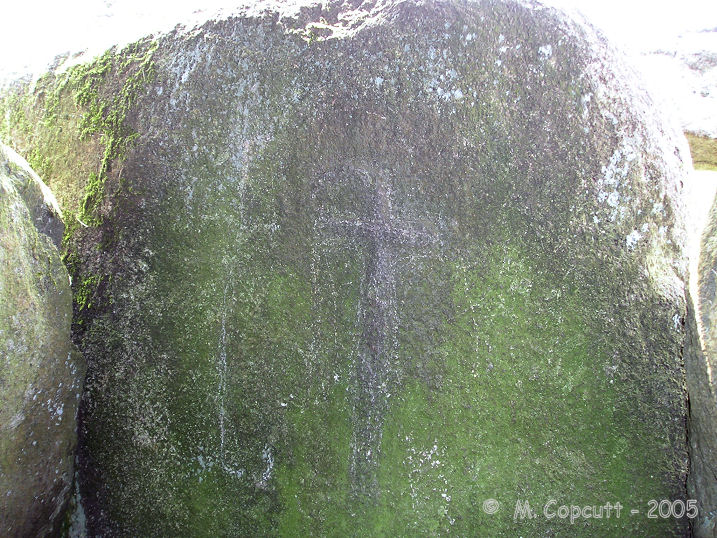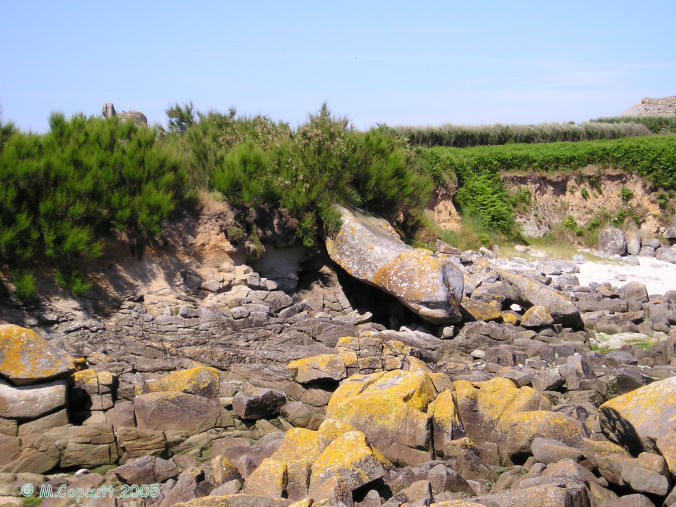Contributory members are able to log private notes and comments about each site
Sites TheCaptain has logged. View this log as a table or view the most recent logs from everyone
Kerguntuil allée couverte
Trip No.203 Entry No.558 Date Added: 3rd Jun 2020
Site Type: Passage Grave
Country: France (Bretagne:Côtes-D'Armor (22))
Visited: Yes on 24th Jun 2005. My rating: Condition 4 Ambience 4 Access 4

Kerguntuil allée couverte submitted by greywether on 26th Jun 2005. Allee couverte from the NE. The entrance is on the right.
(View photo, vote or add a comment)
Log Text: Just about 100 metres upslope from the Kergunteuil dolmen can be found its neighbouring allée couverte, also signposted and kept in a little area. This one again has been incorporated into a field wall at some time in the past, which has no doubt ensured its survival.
It is 8 metres in length, oriented at 070° and has 4 capstones covering the 1.5 metre wide, 1 metre high chamber. The entrance is at the northwest end in the side, but I am not sure if this is the original. Inside the chamber are a few stones with engravings on them, one being particularly spectacular in the middle of the northern side. On it is a row of 6 pairs of outstanding spheres, most of which have a U shape carved beneath them, and which are interpreted as pairs of breasts. There is also another pair higher up. Several "palette" shapes are also carved, and several other symbols. The stone adjacent has a sort of crescent on it. A boat perhaps ? This is an excellent place to visit.
St Samson Chapel well
Trip No.203 Entry No.560 Date Added: 3rd Jun 2020
Site Type: Holy Well or Sacred Spring
Country: France (Bretagne:Côtes-D'Armor (22))
Visited: Yes on 24th Jun 2005. My rating: Condition 4 Ambience 4 Access 5

St Samson Chapel well submitted by Ural on 26th Dec 2012. Site in Bretagne:Côtes-D'Armor (22) France
(View photo, vote or add a comment)
Log Text: Just to the north of the St Samson chapel is a splendid little spring and well house, with clear water bubbling up from within it.
Crec'h Quillé
Trip No.203 Entry No.569 Date Added: 3rd Jun 2020
Site Type: Passage Grave
Country: France (Bretagne:Côtes-D'Armor (22))
Visited: Yes on 24th Jun 2005. My rating: Condition 4 Ambience 3 Access 4

Crec'h Quillé submitted by greywether on 26th Jun 2005. A well-preserved allee-couverte with entrance, E/W chamber and mound. Art on one of the chamber stones opposite the entrance.
Photo looking E, taken June 1994.
(View photo, vote or add a comment)
Log Text: This allée couverte to the south of Perros Guirec is situated just to the east of the busy D.788 dual carriageway, and signposted from it, but most people will go whizzing straight past. From the parking area beside the main road, it is just a couple of hundred metres, but is walking access only. It's set in a nice little plot, probably originally intended for a house when it was discovered in about 1960.
It is surprisingly complete except for the capstones, and still has most of its surrounding mound and outer peristalith of alternating slabs and drystone walling. This is a rarity in these parts, a lateral entry allée couverte, with the main chamber running east west at 073°, and the entrance about two thirds the way along on the southern side.
The chamber is about 15 metres in length, by 1.7 metres width, but its surrounding mound is much larger. Just inside the main chamber, opposite to the entrance, is a smoothed and carved slab, which on one face, facing into the chamber, contains a pair of "breasts" with a large collar or crossed arms underneath. The adjacent face, which faces towards the smaller end of the monument, appears to have a "crosse" shape engraved on it. At this point are two capstones, which no doubt helped to preserve the engravings here. There is the base of a large stone just outside the entry, which is thought to be the base of an indicator menhir. The tumulus has been dated to about 2500BC.
I was going to drive past this myself in a rush to get somewhere else, but I am very glad I did stop to see it, and my visit lasted over an hour, which means I will be late to camp again tonight. A very nice monument.
St-Guinec menhir
Trip No.203 Entry No.548 Date Added: 2nd Jun 2020
Site Type: Standing Stone (Menhir)
Country: France (Bretagne:Finistère (29))
Visited: Yes on 23rd Jun 2005. My rating: Condition 5 Ambience 3 Access 4

St-Guinec menhir submitted by thecaptain on 29th Oct 2004. Menhir Saint-Guinec.
A massive menhir standing in the garden of a house a couple of kilometres west of the village of Huelgoat in Brittany
(View photo, vote or add a comment)
Log Text: Despite being nearly 6 metres tall, this beautiful menhir is becoming obscured from view by a large thick hedge around the garden within which it stands. This is a shame, as it really is a rather nice stone. It can be found just off the Huelgoat to Brennilis road, by the bridge over the busy north / south D.764 highway.
Ty ar Boudiquet Dolmen
Trip No.203 Entry No.545 Date Added: 2nd Jun 2020
Site Type: Burial Chamber or Dolmen
Country: France (Bretagne:Finistère (29))
Visited: Yes on 23rd Jun 2005. My rating: Condition 5 Ambience 4 Access 5

Ty ar Boudiquet dolmen submitted by thecaptain on 29th Oct 2004. Brennilis Dolmen, an Allee Couvert still partially buried under its mound.
Found just outside the small village of Brennilis, about halfway between Brasparts and Huelgoat in western Brittany
(View photo, vote or add a comment)
Log Text: What a lovely monument this is! It's one of my favourites. It is easy to find, just at the northern edge of Brennilis village and clearly signposted, it has a little car park, a picnic area and it lives in a lovely large green and shady area, all very nicely looked after and with birdies tweeting away.
It is a rare dolmen in V form, which is thought to be a transitional stage between dolmens with entry passages (dolmen a couloir) and allée couvertes. It has been dated to about 3000BC.
It is almost complete, and has most of its earthern mound still with it, only a part of the back end has been destroyed by having a wall built through it. The chamber is about 14 metres long and varies in width from about 1 metre wide at the entrance, to nearly 3 metres at full width. The height also varies from about a metre to stand up height. The chamber opens at 125°. The main part of the is covered with three massive capstones, and has within it a standing stone which does not quite reach the roof. Perhaps a stele, but not smoothed and sculpted, or perhaps the remains of an internal wall.
Outside the chamber, the mound is almost complete, and even comes with most of its surrounding peristalith of stones. It is of an oval shape, approximately 17 metres long by 6 metres wide, and still up to 3 metres in height. Unfortunately the back end is cut by a wall and field boundary. The fairies house really is just that. A beautiful place for the little people to live.
Chapelle-des-Sept-Saints
Trip No.203 Entry No.552 Date Added: 2nd Jun 2020
Site Type: Burial Chamber or Dolmen
Country: France (Bretagne:Côtes-D'Armor (22))
Visited: Yes on 23rd Jun 2005

Chapelle-des-Sept-Saints submitted by thecaptain on 5th Jul 2005. Chapelle-des-Sept-Saints, not too far from Lannion in Brittany.
The chapel is built right on top of a dolmen, which makes up the southern crypt, which can be seen through the square entrance, slightly below ground level.
(View photo, vote or add a comment)
Log Text: I had terrible trouble finding this from the south. The road signs are almost non existent, and very inconsistent, and its all windy lanes and farm tracks. None of the roads, or the names on any of the rare signs seem to agree with the maps. I think the maps are in French, while the signs are in Breton ! I eventually found it by a bit of a fluke, after travelling for a fair distance along a road I was wanting to turn round on, and go back, there it was, right in front of me. That said, when I left, and went northwards, it couldn’t be much problem to find it coming from the north, it seems like one road to get there, and its signposted from the main road.
By the time I got here, it was 7:00 pm, and it was all closed up. However, there was a little sign outside telling you about the place in four languages, one of which was English. The Chapel is built right on top of a dolmen, (Stivel dolmen), and the southern Crypt is within the dolmen itself. The dolmen is a big one, and a registered historic monument, being about 4 metres by 2 metres, made with 4 sidestones and 2 capstones. From the outside, there is a little gated doorway, through which you can see partly into the inside, and the dolmen is plain to see. It has been adapted somewhat for its new role, and I think that there are little statues of the seven saints contained in alcoves within the dolmen.
Now this is one way of Christianising an ancient site !!! although it must be said that the chapel is a place of pilgrimage for Moslems. So, there’s at least three beliefs all coming together at the same place.
Mougau Bihan
Trip No.203 Entry No.542 Date Added: 2nd Jun 2020
Site Type: Passage Grave
Country: France (Bretagne:Finistère (29))
Visited: Yes on 23rd Jun 2005. My rating: Condition 5 Ambience 4 Access 5

Mougau Bihan submitted by TheCaptain on 1st Dec 2007. The closing stone between the two chambers has a palette and also a wonderful polished axe, contained within its "crosse".
This is one of the least clear engravings, being much more weatherworn than some which have been better protected.
(View photo, vote or add a comment)
Log Text: This is an absolutely splendid allée couverte, which has been dated to 3000BC, found a couple of kilometres to the south of the village of Commana, and signposted from there. It has a little car park and picnic area, as well as a nice and spacious grassy area around it.
The main chamber is 14 metres in length and oriented approximately north to south, with its entrance at the northern end. The southern end has an extra small chamber, the "cella", the two parts being divided by a splendid "chevet" stone. The roof is made of five large capstones, four on the main chamber, and one on the cella. The internal width and height are about 1.5 metres.
But the best thing about this monument is all the ornamental engravings on the internal faces of the stones. About half of the side slabs have engravings on them which are fairly clear to make out. Most of these engravings are what are called "palettes", some stones having several of these of various designs next to each other. One of the stones has two pairs of the double hemispheres on it - these have been largely interpreted as pairs of breasts. The closing stone between the two chambers has a palette and also a wonderful polished axe, contained within its "crosse", but this is one of the least clear engravings, being much more weatherworn than some which have been better protected.
Mougau Bihan translates from the Breton language to "Fairies Cave".
An-Eured-Ven
Trip No.203 Entry No.544 Date Added: 2nd Jun 2020
Site Type: Stone Row / Alignment
Country: France (Bretagne:Finistère (29))
Visited: Yes on 23rd Jun 2005. My rating: Condition 3 Ambience 4 Access 4

An-Eured-Ven submitted by thecaptain on 13th May 2008. a couple of hundred metre long, slightly curved line of white quartz blocks running along the ridgetop just to the south of the lake.
(View photo, vote or add a comment)
Log Text: On the high moorland to the southwest of the St Michel reservoir, in the bowl below the Montagnes d'Arrée to the southeast of Mont St Michel, can be found some rows of white quartz stones, the name of which, An-Eured-Ven, translates to something approximating the wedding stones dance.
I found a couple of hundred metre long, slightly curved line of white quartz blocks running along the ridgetop just to the south of the lake, the alignment of which varies from 078° to 085° as you go from west to east. Further thoughts on what I found, and I think its perhaps more like two straight rows which converge on a point, or a kinked row, rather than curved. At the kink there is a collection of larger stones which may at one point have been significant. At the eastern end the stones are bigger, and the last stone I found is positioned across the end of the row rather like a Dartmoor blocking stone. The row does not align on St Michel Hill, nor at this eastern end go along the top of the ridge as it runs away at 279°. The western end of the row just seems to fade away into the undergrowth.
Further looking around and I found another line of stones about 100 metres to the north, and which looks to be on an approximately parallel course to the first row. There are lots of other blocks of stone to be seen in amongst the heather, I wonder if a full survey has ever been done here ?
From on top of St Michel Hill, using binoculars, the two rows of stones can clearly be seen, but they form a sort of V shape, with the point towards the east. There is a group of schoolchildren out amongst the rows, with musicians and storytellers. What a great lesson they must be having.
Kerelcun Menhir
Trip No.203 Entry No.551 Date Added: 2nd Jun 2020
Site Type: Standing Stone (Menhir)
Country: France (Bretagne:Finistère (29))
Visited: Yes on 23rd Jun 2005. My rating: Condition 3 Ambience 3 Access 5
Kerelcun menhir submitted by TheCaptain on 30th Oct 2010. Just off the D.764 road by the hamlet of Kerelcun can be found this nearly 5 metre tall, 3 metre wide menhir, standing in a little green area with a picnic table.
(View photo, vote or add a comment)
Log Text: Just off the D.764 road by the hamlet of Kerelcun can be found this nearly 5 metre tall, 3 metre wide menhir, standing in a little green area with a picnic table. It is signposted from the village and easy to find.
Kerampeulven Menhir
Trip No.203 Entry No.549 Date Added: 2nd Jun 2020
Site Type: Standing Stone (Menhir)
Country: France (Bretagne:Finistère (29))
Visited: Yes on 23rd Jun 2005. My rating: Condition 4 Ambience 4 Access 5
Kerampeulven menhir submitted by TheCaptain on 30th Oct 2010. At some time in the past local quarrymen have engraved little pictures onto it. There is a house and several animals, plus a few other shapes and things. The animals are quite jolly.
(View photo, vote or add a comment)
Log Text: Just to the north of the village of Huelgoat, well known for its lake and strange shaped rocks, is this lovely menhir which is signposted from the road to Berrien, and is easy to find. Its about 5 metres tall, and a lovely shape, set in a little grassy area with some nicely shaded picnic tables. At some time in the past local quarrymen have engraved little pictures onto it. There is a house and several animals, plus a few other shapes and things. The animals are quite jolly.
Le Rocher du Diable
Trip No.203 Entry No.543 Date Added: 2nd Jun 2020
Site Type: Standing Stone (Menhir)
Country: France (Bretagne:Finistère (29))
Visited: Yes on 23rd Jun 2005. My rating: Condition 3 Ambience 3 Access 4
Le Rocher du Diable submitted by TheCaptain on 18th Apr 2011. This is a pleasant enough menhir in a field beside the road on the western slopes of the hill upon which the Chapelle St Michel is built. It's approaching three metres in height, nearly as wide at the base, and made of the local quarzite stone, which is pointed at the top.
(View photo, vote or add a comment)
Log Text: This is a pleasant enough menhir in a field beside the road on the western slopes of the hill upon which the Chapelle St Michel is built. It's approaching three metres in height, nearly as wide at the base, and made of the local quarzite stone, which is pointed at the top. There is another block of stone beside it which is the top which was broken off after a lightning strike. With a name like this, there should be legends and stories, but I dont know of any.
Bois de la Roche dolmen
Trip No.203 Entry No.541 Date Added: 2nd Jun 2020
Site Type: Burial Chamber or Dolmen
Country: France (Bretagne:Finistère (29))
Visited: Yes on 23rd Jun 2005. My rating: Condition 2 Ambience 3 Access 4
Bois de la Roche dolmen submitted by TheCaptain on 19th Apr 2011. I am not quite sure exactly what I found here - the pile of rocks I found looked decidedly natural, yet in a very distinctive pile.
Site in Bretagne: Finistère (29) France
(View photo, vote or add a comment)
Log Text: I am not quite sure exactly what I found here - the pile of rocks I found looked decidedly natural, yet in a very distinctive pile with one set on top of three and a large space underneath, and its in exactly the right place compared to the map. I guess its one of those dolmens made using the best locally available materials. In dense woodland, but right at the junction of two country lanes about 3 km north of the village of Commana.
Commana Stèle
Trip No.203 Entry No.540 Date Added: 2nd Jun 2020
Site Type: Standing Stone (Menhir)
Country: France (Bretagne:Finistère (29))
Visited: Yes on 23rd Jun 2005. My rating: Condition 3 Ambience 3 Access 5
Commana Stèle submitted by TheCaptain on 19th Apr 2011. In Commana, on the village green round the back of the church can be found this Iron Age granite stèle.
It is a tapered cylindrical shape just over 2 metres high, and has been christianised by the addition of a cross on the top.
(View photo, vote or add a comment)
Log Text: On the village green by the car park round the back of the church can be found this Iron Age granite stèle. It's a tapered cylindrical shape just over 2 metres high. There are no obvious grooves or other shaping to it.
Leintant menhir
Trip No.203 Entry No.546 Date Added: 2nd Jun 2020
Site Type: Standing Stone (Menhir)
Country: France (Bretagne:Finistère (29))
Visited: Couldn't find on 23rd Jun 2005

Leintant menhir submitted by wiltswarrior on 5th Apr 2015. Site in Bretagne:Finistère (29) France
(View photo, vote or add a comment)
Log Text: Three metre tall menhir, which was probably once part of the nearby alignment.
Alignement de Leintant
Trip No.203 Entry No.547 Date Added: 2nd Jun 2020
Site Type: Stone Row / Alignment
Country: France (Bretagne:Finistère (29))
Visited: Couldn't find on 23rd Jun 2005
Log Text: Row of fallen menhirs now incorporated into a bank at the edge of a field. I could find no trace of this alignment, supposed to contain one standing and three fallen menhirs, which was said to align on mid-summer sunrise. I found the farm, and went up and down the road several times, with no luck. Supposedly, the standing stone is nearly 4 metres tall and beside the road.....
Menhir de Coat Mocun nord
Trip No.203 Entry No.550 Date Added: 2nd Jun 2020
Site Type: Standing Stone (Menhir)
Country: France (Bretagne:Finistère (29))
Visited: Couldn't find on 23rd Jun 2005

Menhir de Coat Mocun submitted by Liamean on 27th Jul 2016. Menhir de Coat Mocun.
(View photo, vote or add a comment)
Log Text: Supposedly 8 metres tall, and re-erected recently when they built the new road, I could not find this. I asked an old gent with a straw hat and waving a stick, who was pushing a wheelbarrow of grass. He took great delight in telling me how I could get to see it, although it was on private land, but he was fairly difficult to understand. From what I did understand, I thought he said it was in a quarry area, I had several looks, from various points of attack, but could not find it. Bummer.
Ty-Lia (Île Grande)
Trip No.203 Entry No.553 Date Added: 2nd Jun 2020
Site Type: Passage Grave
Country: France (Bretagne:Côtes-D'Armor (22))
Visited: Yes on 23rd Jun 2005. My rating: Condition 4 Ambience 3 Access 5

Ty-Lia (Ile Grande) submitted by greywether on 26th Jun 2005. Allee-couverte surrounded by stones marking the edge of the mound.
(View photo, vote or add a comment)
Log Text: This looks to be a fairly complete standard allée couverte well signposted and in a little grassy area on Ile-Grande, just off the coast near Trebeurden. It is about 9 metres long by 1.5 metres wide, and oriented to 110°. There are two large capstones which cover most of the chamber. Many of the outer peristalith stones survive, particularly on the southern side and the back end, and there are traces of the mound within them.
Barnenez Cairn
Trip No.203 Entry No.539 Date Added: 29th May 2020
Site Type: Chambered Cairn
Country: France (Bretagne:Finistère (29))
Visited: Yes on 22nd Jun 2005. My rating: Condition 5 Ambience 3 Access 4

Barnenez Cairn submitted by thecaptain on 17th Oct 2004. Barnenez Cairn.
View of the quarried away bit of the northwestern side, showing the remains of one of the central chambers.
When the workmen found these internal structures in 1955, the thankfully stopped taking the stone away to make roads, and we are thankfully left with the majority of this wonderful tomb still here after 6500 years.
(View photo, vote or add a comment)
Log Text: This magnificent large cairn, is now signposted from miles around as Le Grand Cairn (de Barnenez). It costs €4.60 to get in, and there is a little visitor centre and shop, with replicas of some of the carved stones on display. Unlike 12 years ago, or whenever, you cannot go into many of the chambers, which are now walled off fairly crudely and unimaginatively, which I think really spoils the place. Its not just that you cant get in, but the way its been done really detracts from the view of the cairn and all its many entrances.
Only two chambers and passages are now open, these being the two beehive construction open chambers, but these seem to be cracking and breaking up. I was told by the man in the centre that they are not, and that they have been like that since their discovery. Perhaps its my memory, but I wonder if the 1960s restoration work is not lasting anywhere near so long as the original 6,000 year old work!
It's still a mighty impressive and imposing tomb sitting on top of its headland, and I think that more land has been cleared around it, allowing much better views over the Bay of Morlaix on one side, and Anse de Terenez on the other, which during this visit were full with a high tide, making the whole place seem truly wonderful.
I got talking to the men in the shop, and they were interested to hear about what I was doing, and one of the guys suggested a couple of places that I shouldn't miss. Commana allee couverte near Roche Trevezel, and Chapelle des Sept Saints near Lannion - a chapel built on top of a dolmen, which can still be seen.
Grand menhir de Saint-Eden
Trip No.203 Entry No.532 Date Added: 28th May 2020
Site Type: Standing Stone (Menhir)
Country: France (Bretagne:Finistère (29))
Visited: Yes on 22nd Jun 2005. My rating: Condition 2 Ambience 3 Access 3

Grand menhir de Saint-Eden submitted by thecaptain on 20th May 2006. Laying fallen at the edge of the sea is the almost forgotten St Eden grand menhir.
(View photo, vote or add a comment)
Log Text: This is the menhir that the chap I met last night was telling me about, right at the edge of the Grève (rocky shore), and unfortunately the sea has claimed it. It is now fallen and laying top down into the sea when the tide is in. Perhaps its one of those menhirs that came down to the sea to drink at midnight, had too much and didnt make it back. Or perhaps came down one night when the tide was not a big one, and fell over while trying to quench its thirst. Whatever, its a great pleasure to find this almost forgotten stone which is not marked on any map.
The stone is a lovely top heavy shape, some would say phallic, and about 8 metres in length. Its a pity it cant be re-erected somewhere, although obviously not in its original cliff edge position. There was an old farmer chap working in some fields nearby who told me that he could remember it standing, but he had no idea when it fell, but it was a long time ago. Fantastic.
Menhir de Kergoarat
Trip No.203 Entry No.533 Date Added: 29th May 2020
Site Type: Standing Stone (Menhir)
Country: France (Bretagne:Finistère (29))
Visited: Yes on 22nd Jun 2005. My rating: Condition 5 Ambience 5 Access 4
Menhir de Kergoarat submitted by thecaptain on 1st Dec 2006. Splendidly shaped 7 metres tall menhir standing on its little headland beyond the Cam Louis beach.
As with most of the stones round here, it is a wonderfully weathered rock.
(View photo, vote or add a comment)
Log Text: In contrast to its bulbous headed, thirsty neighbour, this fine chap looks to be wearing a pointy hat. He must be a good 7 metres tall and standing perfectly upright on this little headland beyond the beach. As with most of the stones round here, it is a wonderfully weathered rock, and from certain angles it has a face in it, looking out over the sea.
